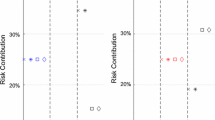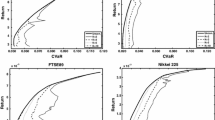Abstract
It is well known that the traditional estimated risk for the Markowitz mean-variance optimization had been demonstrated to seriously depart from its theoretic optimal risk due to accumulation of input estimation errors. Fan et al. (in J. Am. Stat. Assoc. 107:592–606, 2012a) addressed the problem by introducing the gross-exposure constrained mean-variance portfolio selection. In this paper, we present a direct approach to estimate the risk for vast portfolios using asynchronous and noisy high-frequency data. This approach alleviates accumulation of the estimation error of tens of hundreds of integrated volatilities (or co-volatilities), and on the other hand it has the advantage of smoothing away the microstructure noise in the spatial direction. Based on the simple approach, together with the “pre-averaging” technique, we obtain a sharper bound of the risk approximation error than that in Fan et al. (in J. Am. Stat. Assoc. 107:412–428, 2012b). This bound is locally dependent on the allocation plan satisfying the gross-exposure constraint. The bound does not require exponential tail of the distribution of the microstructure noise. Finite fourth moment suffices. Our work also demonstrates that the mean squared error of the risk estimator can be decreased by choosing an optimal tuning parameter depending on the allocation plan. This is more pronounced for the moderately high-frequency data. Our theoretical results are further confirmed by simulations.

Similar content being viewed by others
References
Barndorff-Nielsen OE, Hansen PR, Lunde A, Shephard N (2008) Multivariate realized kernels: consistent positive semi-definite estimators of the covariation of equity prices with noise and non-synchronous trading. J Econom 162:149–169
Fan J, Fan Y, Lv J (2008) Large dimensional covariance matrix estimation via a factor model. J Econom 147:186–197
Fan J, Wang Y (2007) Multi-scale jump and volatility analysis for high-frequency financial data. J Am Stat Assoc 102:1349–1362
Fan J, Zhang J, Yu K (2012a) Asset allocation and risk assessment with gross exposure constraints for vast portfolios. J Am Stat Assoc 107:592–606
Fan J, Li Y, Ke Y (2012b) Vast volatility matrix estimation using high frequency data for portfolio selection. J Am Stat Assoc 107:412–428
Frost PA, Savarino JE (1986) An empirical Bayes approach to efficient portfolio selection. J Financ Quant Anal 21:293–305
Jacod J, Li Y, Mykland PA, Podolskij M, Vetter M (2009) Microstructure noise in the continuous case: the pre-averaging approach. Stoch Process Appl 119:2249–2276
Jagannathan R, Ma T (2003) Risk reduction in large portfolios: why imposing the wrong constraints helps. J Finance 58:1651–1683
Klein RW, Bawa VS (1976) The effect of estimation risk on optimal portfolio choice. J Financ Econ 3:215–231
Ledoit O, Wolf M (2004) A well-conditioned estimator for large-dimensional covariance matrices. J Multivar Anal 88:365–411
Markowitz HM (1952) Portfolio selection. J Finance 7:77–91
Markowitz HM (1959) Portfolio selection: efficient diversification of investments. Wiley, New York
Podolskij M, Vetter M (2009) Estimation of volatility functionals in the simultaneous presence of microstructure noise and jumps. Bernoulli 15:634–658
Wang Y, Zou J (2010) Vast volatility matrix estimation for high-frequency financial data. Ann Stat 38:943–978
Zhang L (2006) Efficient estimation of volatility using noisy observations. Bernoulli 12:1019–1043
Zhang L (2012) Estimating covariation: Epps effect and microstructure noise. J Econom 160:33–47
Zhang L, Mykland PA, Ait-Sahalia Y (2005) A tale of two time scales: determining integrated volatility with noisy high-frequency data. J Am Stat Assoc 100:1394–1411
Acknowledgements
This work is supported in part by the NSF China (11201080) and in part by the Humanity and Social Science Youth Foundation of Chinese Ministry of Education (12YJC910003).
Author information
Authors and Affiliations
Corresponding author
Appendix: Outlined proofs of main theorems
Appendix: Outlined proofs of main theorems
In this section, we provide the outline of the proof of main theorems. The detailed proof is available from the author upon request. In the sequel we assume that C is a generic constant which may take different values at different appearance. Recall that \(X^{*}_{t_{j}}=\sum^{p}_{k=1}w_{k}X^{*k}_{j}\), \(\epsilon^{*}_{t_{j}}=\sum^{p}_{k=1}w_{k}\epsilon^{*k}_{t_{j}}\), \(X(t)=\sum^{p}_{k=1}w_{k}X^{k}(t)\), and \(\epsilon_{t_{j}}=\sum^{p}_{k=1}w_{k}\epsilon^{k}_{t_{j}}\) for 0≤j≤n. Let \(\overline{X}(i)=\sum^{L_{i}+1}_{j=L_{i-1}+1}g_{j}^{i}\varDelta ^{n}_{j}X\) and \(\overline{\epsilon}(i)=\sum^{L_{i}+1}_{j=L_{i-1}+1}g_{j}^{i}\varDelta ^{n}_{j}\epsilon\), where \(\varDelta ^{n}_{j}X=X(t_{j})-X(t_{j-1})\) and \(\varDelta ^{n}_{j}\epsilon=\epsilon_{t_{j}}-\epsilon_{t_{j-1}}\). \(\overline{X^{*}}(i)=\sum^{L_{i}+1}_{j=L_{i-1}+1}g^{i}_{j}\varDelta ^{n}_{j}X^{*}\) and \(\overline{\epsilon^{*}}(i)=\sum^{L_{i}+1}_{j=L_{i-1}+1}g^{i}_{j}\varDelta ^{n}_{j}\epsilon^{*}\) where \(\varDelta ^{n}_{j}X^{*}=X^{*}_{t_{j}}-X^{*}_{t_{j-1}}\) and \(\varDelta ^{n}_{j}\epsilon ^{*}=\epsilon^{*}_{t_{j}}-\epsilon^{*}_{t_{j-1}}\). Then \(\overline{Y}(i)=\overline{X}(i)+\overline{\epsilon}(i)\) and \(\overline{Y*}(i)=\overline{X^{*}}(i)+\overline{\epsilon^{*}}(i)\). And our estimator of the integrated volatility of X is
We first give some lemmas related to the terms in (A.1), the proofs of which are omitted.
Lemma 1
Under Assumptions 1, 3 and 4,
If m→∞,
Lemma 2
Under Assumptions 2 and 3,
where \(\mu_{2}=E\epsilon_{t_{1}}^{2}\) and \(\mu_{4}=E\epsilon_{t_{1}}^{4}\).
Lemma 3
Lemma 4
where n ∗ is the totality of sample sizes before data synchronization.
Lemma 5
1 and 2 in Theorem 1 hold.
Lemma 6


and
Proof of Theorem 1
Seen from Lemmas 1–4, we find that
and 3–5 of Theorem 1 are proved. Now we go to the last term in (A.11) which can be decomposed as follows:
By Lemma 6, the second and the third term are \(O_{P}(\sqrt {(\frac{m}{n})^{3}}\frac{1}{\sqrt{n}})\), and \(O_{P}(\sqrt{\frac {m}{n}}\frac{1}{\sqrt{n}})\). Therefore we proved the decomposition in Theorem 1. 1 and 2 of Theorem 1 are guaranteed by Lemma 5.
Proof of Theorem 2
We have the following decomposition:
By (A.2),
By Lemma 5, we have
Then Theorem 2 results from the following lemma.
Lemma 7
Under the conditions in Theorem 2, we have
Proof of Proposition 1
To save space, we only prove the result when k=l. For the result when \(k\not=l\), the proof is similar. As in (A.13), we have
Similarly to (A.2), one has
Similarly to (A.15), we have
Therefore the fifth and sixth term in (A.22) is negligible. Now it suffices to prove Lemma 8, the proof of which is omitted.
Lemma 8
For x∈(0,c 5 n 1/4], we have
Proof of Theorem 3
It suffices to prove that for any B n →∞ satisfying B n ≤logn,
By the expansion, we have on \(\{(\tilde{{\bf w}}_{\mathrm{opt}}-{\bf w}_{\mathrm{opt}})^{T}(\tilde{{\bf w}}_{\mathrm{opt}}-{\bf w}_{\mathrm{opt}})\geq\frac {MB_{n}}{n^{1/4}}\}\) for any M>0,
On the other hand, by Theorem 2 and Corollary 1, on \(\{(\tilde{{\bf w}}_{\mathrm{opt}}-{\bf w}_{\mathrm{opt}})^{T}(\tilde{{\bf w}}_{\mathrm{opt}}-{\bf w}_{\mathrm{opt}})\geq\frac{MB_{n}}{n^{1/4}}\}\),
with probability arbitrarily close to 1 for large enough M and n. This is a contradiction with the definition of \(\tilde{{\bf w}}_{\mathrm{opt}}\). □
Rights and permissions
About this article
Cite this article
Kong, XB. A direct approach to risk approximation for vast portfolios under gross-exposure constraint using high-frequency data. TEST 22, 647–669 (2013). https://doi.org/10.1007/s11749-013-0337-3
Received:
Accepted:
Published:
Issue Date:
DOI: https://doi.org/10.1007/s11749-013-0337-3




